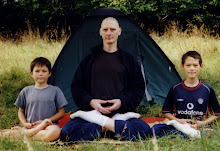KANKI ISSOKU: Not Doing a Deep Breath
KI breath, oxygen, ki
ICHI one
SOKU breath
KANKI ISSOKU
“Breathe out fully once”
If the head and spine are being directed upwards, without undue fixity in the joints or narrowing of the back, then, in order to breathe out fully, the naturally inherent outward-springing tendency of the rib-cage must be opposed by some muscular doing. An intention must be formed to breathe out fully; a decision must be made to breathe out fully.
When this decision is acted upon, the direction of the muscles governing rib movement, and the direction of the bony rib-cage itself, are antagonistic to each other; the former are pushing the rib-cage in, while the tendency of the latter is to spring out.
When the musuclar doing stops, when we stop breathing out, then -- providing the effort to breathe out hasn’t caused us to collapse down or to stiffen up -- there is nothing to prevent the rib-cage springing out again. This springing apart of the ribs creates a partial vacuum in the lungs. There instantly follows a spontaneous flow of air into the lungs -- a natural, deep in-breath. Thus a natural deep breath is a bit of nothing, a bit of non-doing.
I have attempted to describe, as FM Alexander described them, the the conscious, indirect means-whereby a natural, deep in-breath may be taken.
Notice that Master Dogen’s instructions, like those of Alexander, do not direct our attention to the end. We are not told to take a deep breath. Our attention is directed to the means. Master Dogen tells us just to sit upright (SUNAWACHI SHOSHIN TANZA), directing ears vs shoulders (MIMI TO KATA TO), and nose vs navel (HANA TO HESO TO) away from each other, and thus to breathe out fully once (KANKI ISSOKU).
Master Dogen’s intention throughout Fukan-zazengi is like this. Sitting-zen is the practice and experience that gets to the bottom of the Buddha’s enlightenment (BODAI O GUJIN SURU NO SHUSHO NARI). The Buddha’s enlightenment is the end we wish to gain, not only for our own sake but for the sake of others too. But even if our motivation is unselfish, altruistic, still we mustn’t go for the end directly, we mustn’t grasp for it unconsciously -- we mustn’t end-gain. Just sitting at ease in the lotus posture, without end-gaining for anything, is the means that will take us happily to the other side.
Easier said than done. After practicing KANKI ISSOKU, for example, to allow a deep breath just to flow in spontaneously, without me getting in the way, without me adding a bit of a sniff of my own, is not so easy. Generally, by the time I have even thought the word “breath” I am already in the way.
Just sitting at ease in the lotus posture is the simplest thing in the world. But Master Bodhidharma, who transmitted the mind-seal at Shaolin (SHORIN NO SHIN-IN O TSUTAURU), where he sat facing the wall for nine years (MENPEKI KYUSAI), never said it was easy.


0 Comments:
Post a Comment
<< Home